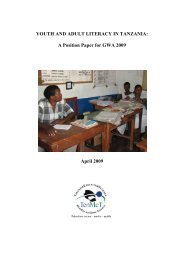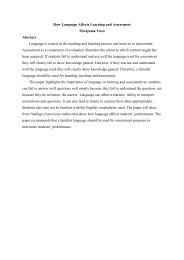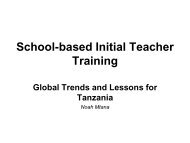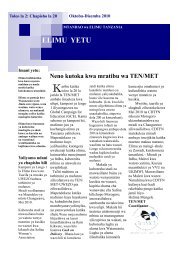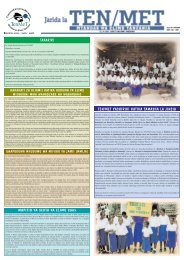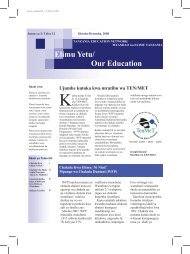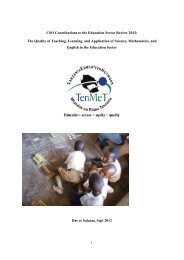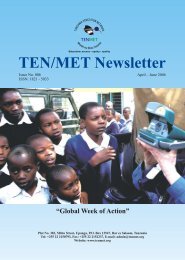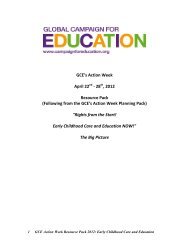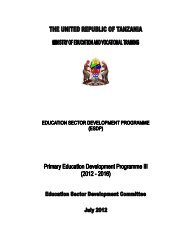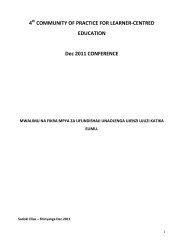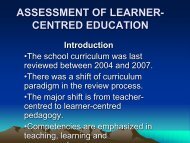Status of Children in Tanzania - 2012 - Tanzania Education Network ...
Status of Children in Tanzania - 2012 - Tanzania Education Network ...
Status of Children in Tanzania - 2012 - Tanzania Education Network ...
Create successful ePaper yourself
Turn your PDF publications into a flip-book with our unique Google optimized e-Paper software.
Call for Action<br />
Urban population 26% National Bureau <strong>of</strong> Statistics <strong>of</strong><br />
<strong>Tanzania</strong><br />
Male population 49% National Bureau <strong>of</strong> Statistics <strong>of</strong><br />
<strong>Tanzania</strong><br />
Female population 51% National Bureau <strong>of</strong> Statistics <strong>of</strong><br />
<strong>Tanzania</strong><br />
Population (thousands), 2009, under18 22416 5 National Bureau <strong>of</strong> Statistics <strong>of</strong><br />
<strong>Tanzania</strong><br />
Mortality Rate (2011) 790/100,000 The UN Child Mortality Report<br />
<strong>2012</strong><br />
Primary school net enrolment/ attendance 73 1 Basic <strong>Education</strong> statistics<br />
(%), 2005-2009<br />
HIV/AIDS prevalence among 15-24<br />
2.5% Basic <strong>Education</strong> statistics<br />
year-olds (2007)<br />
Estimated adult HIV prevalence rate 5.6 1 Basic <strong>Education</strong> statistics<br />
(aged15-49), 2009<br />
Poverty Figures Source<br />
Gross Domestic Product (GDP) per capita 1,208 (Purchas<strong>in</strong>g Power<br />
Parity/PPP US$, 2007)<br />
443 US$ (2008)<br />
Annual growth rate <strong>in</strong> real GDP 7.1%(2007) 7.4%(2008)<br />
Annual growth rate <strong>in</strong> services 8.1%(2007) 8.5%(2008)<br />
Inflation (2009)<br />
GNI per capita (US$), 2009 5006<br />
Poverty head count ratio at national poverty<br />
l<strong>in</strong>e (% <strong>of</strong> population)<br />
12.1% (IMF)<br />
33,4%7<br />
Unemployment total (%<strong>of</strong> total labour force) 4.3%8<br />
Human rights <strong>in</strong>struments<br />
UNCRC <strong>Status</strong> Acceptance<br />
Ratified: UNCRC: signed 1991 OPSC Signed<br />
UNCRC Reports First 2001<br />
HC on Inter-country Adoption<br />
Not signed or ratified<br />
Child protection statistics Figures Source<br />
Child labour 2000-2009, total 21% 1<br />
Birth registration 2000-2009, total 22 1<br />
Birth registration 2000-2009, urban 48 1<br />
Birth registration 2000-2009, rural 16 1<br />
Female genital mutilation/cutt<strong>in</strong>g,<br />
15 1<br />
women1997-2009, total<br />
Female genital mutilation/cutt<strong>in</strong>g,<br />
4 1<br />
daughters1997-2008, total<br />
Human Development Index<br />
Figures<br />
Rank 152<br />
Health Life expectancy (2008)<br />
Men<br />
<br />
Women<br />
53<br />
55<br />
Source<br />
Table 2, <strong>in</strong>dicates that <strong>Tanzania</strong> has a highest population <strong>in</strong> East Africa and projected to be 44.5 million by<br />
<strong>2012</strong>. Majority <strong>of</strong> these people 74% reside <strong>in</strong> rural areas. The population growth rate stands at 2.9%. In human<br />
development <strong>in</strong>dex, it ranks 152 <strong>in</strong> the world mak<strong>in</strong>g it to be among the 3 poorest country <strong>in</strong> the world.<br />
The GDP growth rate is 7.1% the lowest <strong>in</strong> the East Africa Region. With this features socially and economically<br />
<strong>Tanzania</strong> is poorest <strong>in</strong> the region with a very limited <strong>in</strong>dustrial base. In healthy wise <strong>Tanzania</strong> has been<br />
seriously affected by HIV/AIDS s<strong>in</strong>ce 1993. HIV prevalence rate aged 15-49 stood at 5.6% nationally. The<br />
prevalence rate is very high <strong>in</strong> some regions <strong>in</strong> <strong>Tanzania</strong>, for example <strong>in</strong> Ir<strong>in</strong>ga people aged between 15-49 the<br />
prevalence rate stands at 15.5%, Mbeya 12.4%, Mwanza 8.1%, Ruvuma 7.4%, Sh<strong>in</strong>yanga 6.7%, Dodoma 6%,<br />
Tanga 5.8%, Tabora 6.2%, Mtwara 4.4%, Kilimanjaro 4.7%, Arusha 4.3%. In view <strong>of</strong> such statistics, few years<br />
5 http://www.unicef.org/<strong>in</strong>fobycountry/tanzania_statistics.html<br />
6 http://www.unicef.org/<strong>in</strong>fobycountry/tanzania_statistics.html<br />
7 http://data.worldbank.org/country/tanzania<br />
8 http://data.worldbank.org/country/tanzania<br />
8 / 55 <strong>Tanzania</strong>-CRSA-REPORT-<strong>2012</strong><br />
A lov<strong>in</strong>g home for every child




